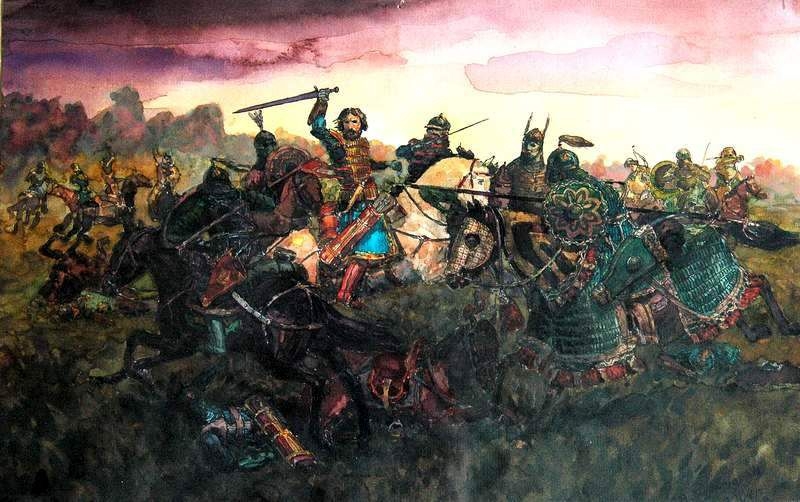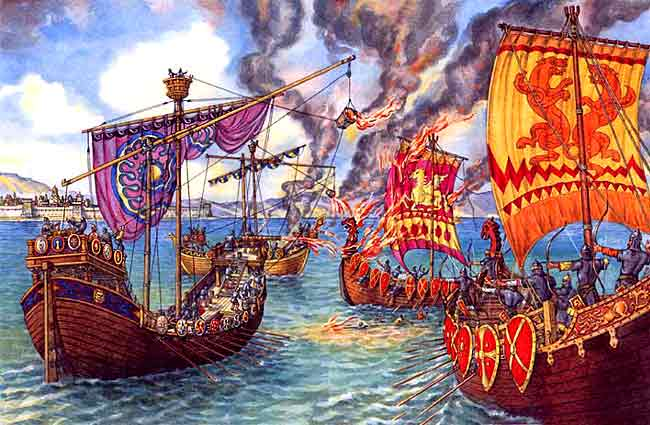
Battle of the Kalka River
The process of feudal fragmentation from the middle of the XI century Kievan state and the resumption of new raids by the nomads began to historical background, which developed Russian martial art. These factors, along with the development of the feudal way of life in society and the improvement of military equipment, determined the character of Russian military art and especially in Russia.
As for the acquisition of troops, its composition was different, everything depended on the nature and goals of the war. In each case, these wars participated boyars with his troops and, of course, personal retinue of Prince, and volunteers - so-called "hunters" of the cities population. should say, that these forces are often supplemented by urban militias and rarely - rural.
Squad and militia gathered the prince himself and the commanders - tysyatskiye after the adoption of specific solutions, eg, about a hike or an attack on the enemy. collecting process lasted for about one week. A large area of the principalities, such as Vladimir-Suzdalskoe or Novgorodskoe, - a little more than a week. For example: army to resist the Mongols on the river Kalka in 1223 It was going to more than one month. The organization squads big changes were not: as before it was divided into senior and junior. But some changes were caused by the incessant internecine struggles. Each of the princes sought to counterbalance Boyar opposition strengthen the youngest squad at the expense of the number of. As part of the youngest squads had such a category of soldiers with the time as "milostniki". They got armor, including horse from Prince. Over time, the service acquired hereditary. It should be noted, that from the middle of the XII century in ancient Russia there is another category of soldiers - "saddlers". Likely, These people belonged to settlers, which were dependent on the prince. They fought in the light cavalry. Residents steppe borderland Russia, who inhabited the fortress of the southern borders, They were part of the prince's retinue. But with time, especially with the aggravation of the internecine conflict, they became independent and combined with a normal life guard service.
In terms of the organization of the army of Russia at that time consisted of infantry and cavalry. Infantry were militia from a poor part of the population. Over time, the role of this kind of troops gradually underwent changes. The infantry alone can be used as a landing or during the siege, assault and defense of fortresses. But the importance of cavalry in the army of ancient Russia has been increasing. The cavalry was divided into heavy and light. should say, that full-fledged soldiers at the time were considered only "oruzhniki", ie heavy cavalry. They both have full protection, and offensive weapons. Long peak and served them sword weapon.

rook
The light cavalry served basis and accounted for its generic group of nomads (Torquay, Berendeans, kovui), as well as soldiers of the youngest squads and militias. It should be noted, that the allocation of a part of the cavalry light cavalry in Russia occurred earlier, than in Western countries. This indicates, that was a big step forward in the development of the art of war.
As for military navigation in Russia, it developed only in Novgorod. The confirmation may serve as a campaign of Novgorod with Korel in 1188 year Swedish capital Sigtuna. However, in each principality ancient river Rus had flotilla (ship's Men) warships - planted a.
It does not lag behind the development and military equipment. In the middle of the XII century there were catapults, as well as hand-held crossbows (crossbows). They got their spread primarily in the western Russian lands.
Russian army at that time was divided into regiments, They were formed due to the militias of large cities. Order of battle was polchny number. Shelves were divided into banners - large groups of feudal lords, urban militias. Banners, in turn, were divided into tactical units - "spear". The number of copies was about 15-20 people. But the number of banners in the regiment, as well as copies respectively in banners often changed. Signals in Russian army infantry fed via tambourine, and cavalry - tubes.
Traditional character in Kievan Rus were warriors questions of training and education. The foundation of military training were daily exercises in riding, fehtovanii, archery, etc.. There are cases (Western sources) participation of Russian soldiers in knightly tournaments at European courts. Greater role in military training continued to play zverovaya hunting, she developed individual skills with weapons and riding, but mostly a psychological training.
social relations changes contributed to the formation of the corresponding moral values warriors. Unlike other countries in the XIII century in Russia love of country it was closely linked with the honor and valor of the warrior, brought up on the ideals of the Orthodox Faith. A special role for the formation of moral and psychological qualities of the Russian soldiers playing folk epic. All this had an impact on the education of the soldiers and the development of military traditions.
Here is an example of morality Russian soldiers of that period: "Best men" troops Igor Novgorod-Seversky was considered a sin to throw their "simple" by fellow soldiers and break out of the encirclement, so they prefer the death or captivity of life, produced betrayal price.Gabriel Tsobehiya











